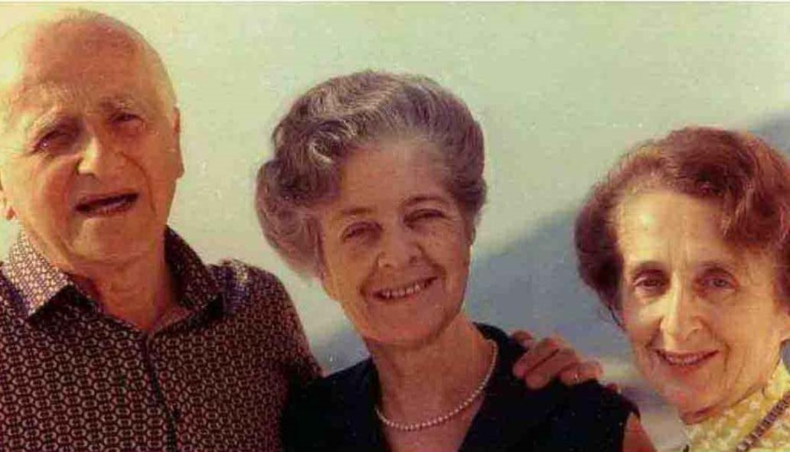“My aunt Rita Levi-Montalcini, artist of science”

By Daniel Reichel
A patient reading of hundreds of letters that Ri – this was Rita Levi-Montalcini’s nickname as a child – sent to her family. In particular the correspondence with her father Adamo, an engineer who moved from Turin to Bari to design ice factories, but also the missives to her siblings Gino, Anna, and her twin Paola. A great heritage of documents comprising also pictures, report cards and newspapers of that period, items that tell a personal story and that constitute an important part of the history of Italy in the twentieth century. On the 10th anniversary of her passing, the scientist’s niece, Piera Levi-Montalcini, set to work on a way to honour aunt Rita. She went through all the documents, looking back at the childhood of the famous scientist and retracing the steps that took her from setting up an illegal Laboratory in Turin in the 1940s to making extraordinary discoveries and being the first and as of today only Italian woman to be awarded the Nobel Prize.
 The result is a book co-signed with Alberto Cappio, head of research at the Levi-Montalcini Archive, titled “Un sogno al microscopio. Il viaggio verso il Nobel di Rita Levi-Montalcini” (A dream under the microscope. Rita Levi-Montalcini’s journey to the Nobel). The book is aimed at young people, and it opens with some quotes that from the very beginning offer important lessons. “Those who study know they are never going to win, not even if they get a Nobel Prize. Yet they also know they cannot lose”. And more: “The head. Some people bow it, some hide it, some lose it. I prefer those who use it”. Also: “I believe in ethics, without it, life has no meaning, and it is not even worth living”. These aphorisms sum up the mind of, as the niece calls her, an artist of science about whom there is still much to discover. Piera Levi-Montalcini promotes this heritage by organising editorial projects, school activities and research initiatives.
The result is a book co-signed with Alberto Cappio, head of research at the Levi-Montalcini Archive, titled “Un sogno al microscopio. Il viaggio verso il Nobel di Rita Levi-Montalcini” (A dream under the microscope. Rita Levi-Montalcini’s journey to the Nobel). The book is aimed at young people, and it opens with some quotes that from the very beginning offer important lessons. “Those who study know they are never going to win, not even if they get a Nobel Prize. Yet they also know they cannot lose”. And more: “The head. Some people bow it, some hide it, some lose it. I prefer those who use it”. Also: “I believe in ethics, without it, life has no meaning, and it is not even worth living”. These aphorisms sum up the mind of, as the niece calls her, an artist of science about whom there is still much to discover. Piera Levi-Montalcini promotes this heritage by organising editorial projects, school activities and research initiatives.
How was it to go through the family archives?
It was a great journey. There are countless letters that the children sent to their father and to each other. The documents are about three thousand, dating from the 1920s to the 1930s, with the interruption of the war period. Going through them, I was able to piece together the history of that period and of my family. What emerges is the deep bond, affection and complicity between parents and siblings, that remained strong even despite the tough times and the violence of the Racial Laws and of the war.
Are there still things to discover from the letter archive?
Of course. I only went through part of it, but it should be studied and valorized as a whole. You can find out interesting facts, like aunt Rita sewing a blouse to graduate from high school. One can only imagine how that would be the final exam of a future Nobel Prize winner, and you can get a better sense not only of her figure, but also of the historical context of the period she lived in and the difficulties she had to face.
The book also tells the story of a young Rita Levi-Montalcini that struggled in school.
Yes, Rita also had her ups and downs, and we were surprised to find a middle school report card that showed she had gotten a 5 out of 10. It serves as a meaningful example for young people: you don’t always find your path straight away. And it took my aunt a long time to trace out her future. She also was the last one to make a name for herself, since for a long time my dad Gino and my aunt Paola were the famous ones of the family. The former appeared in all the architecture books, and the latter had her work shown in art exhibitions everywhere. But my father knew that my aunt Rita would become successful. She was an artist of science.
It seems that the bond between siblings was very strong. Could it become a subject of study?
In the family, they used to talk to each other a lot. The letter exchanges and material regarding the Levi-Montalcini family form a heritage that I wish could be further valorized. It should be collected systematically, and my dream is to start a research centre dedicated to my aunt and to the bond with her siblings. It can be located anywhere. Whether in Turin, Saint Louis or Israel, I just wish to establish a place where to work on the whole family universe.
From the top, Gino, Rita e Paola Levi-Montalcini and the cover of the book by the niece Piera and Alberto Cappio.
Translated by Annadora Zuanel, revised by Martina Bandini, students at the Secondary School of Modern Languages for Interpreters and Translators of the University of Trieste, interns at the newspaper office of the Union of the Italian Jewish Communities – Pagine Ebraiche.
